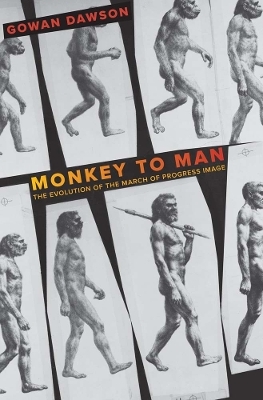
Monkey to Man
The Evolution of the March of Progress Image
Seiten
2024
Yale University Press (Verlag)
978-0-300-27062-4 (ISBN)
Yale University Press (Verlag)
978-0-300-27062-4 (ISBN)
The first book to examine the iconic depiction of evolution, the “march of progress,” and its role in shaping our understanding of how humans evolved
“Dawson wears his considerable learning and his deep research into previously underused archives lightly. He has written a wonderful book.”—Greg Priest, Journal of the History of Biology
We are all familiar with the “march of progress,” the representation of evolution that depicts a series of apelike creatures becoming progressively taller and more erect before finally reaching the upright human form. Its emphasis on linear progress has had a decisive impact on public understanding of evolution, yet the image contradicts modern scientific conceptions of evolution as complex and branching.
This book is the first to examine the origins and history of this ubiquitous and hugely consequential illustration. In a story spanning more than a century, from Victorian Britain to America in the Space Age, Gowan Dawson traces the interconnected histories of the two most important versions of the image: the frontispiece to Thomas Henry Huxley’s Evidence as to Man’s Place in Nature (1863) and “The Road to Homo Sapiens,” a fold-out illustration in the best-selling book Early Man (1965). Dawson explores how the recurring appearances of this image pointed to shifting scientific and public perspectives on human evolution, as well as indicated novel artistic approaches and advancements in technology.
“Dawson wears his considerable learning and his deep research into previously underused archives lightly. He has written a wonderful book.”—Greg Priest, Journal of the History of Biology
We are all familiar with the “march of progress,” the representation of evolution that depicts a series of apelike creatures becoming progressively taller and more erect before finally reaching the upright human form. Its emphasis on linear progress has had a decisive impact on public understanding of evolution, yet the image contradicts modern scientific conceptions of evolution as complex and branching.
This book is the first to examine the origins and history of this ubiquitous and hugely consequential illustration. In a story spanning more than a century, from Victorian Britain to America in the Space Age, Gowan Dawson traces the interconnected histories of the two most important versions of the image: the frontispiece to Thomas Henry Huxley’s Evidence as to Man’s Place in Nature (1863) and “The Road to Homo Sapiens,” a fold-out illustration in the best-selling book Early Man (1965). Dawson explores how the recurring appearances of this image pointed to shifting scientific and public perspectives on human evolution, as well as indicated novel artistic approaches and advancements in technology.
Gowan Dawson is professor of Victorian literature and culture at the University of Leicester and honorary research fellow at the Natural History Museum, London. His work combines the history of science with cultural, literary, and art history. He lives in Leicestershire, UK.
| Erscheinungsdatum | 11.02.2024 |
|---|---|
| Zusatzinfo | 7 color + 75 b-w illus. |
| Sprache | englisch |
| Maße | 156 x 235 mm |
| Themenwelt | Kunst / Musik / Theater |
| Geschichte ► Teilgebiete der Geschichte ► Kulturgeschichte | |
| Naturwissenschaften ► Biologie ► Evolution | |
| Naturwissenschaften ► Biologie ► Humanbiologie | |
| ISBN-10 | 0-300-27062-3 / 0300270623 |
| ISBN-13 | 978-0-300-27062-4 / 9780300270624 |
| Zustand | Neuware |
| Informationen gemäß Produktsicherheitsverordnung (GPSR) | |
| Haben Sie eine Frage zum Produkt? |
Mehr entdecken
aus dem Bereich
aus dem Bereich
der stille Abschied vom bäuerlichen Leben in Deutschland
Buch | Hardcover (2023)
C.H.Beck (Verlag)
CHF 32,15
Die Revolution des Gemeinen Mannes
Buch | Softcover (2024)
C.H.Beck (Verlag)
CHF 16,80


